When technology truly lands and becomes universal, people will no longer refer to it as "AI."
Written by: Bu Shuqing
Source: Wall Street Watch
"AI is devouring the world, and we haven't even seen what it looks like."
In the latest report titled "AI eats the world," renowned tech analyst and former a16z partner Benedict Evans provides a judgment that could shake the entire tech world: generative artificial intelligence is triggering a major platform shift in the tech industry every ten to fifteen years, and we still do not know where it will ultimately lead.
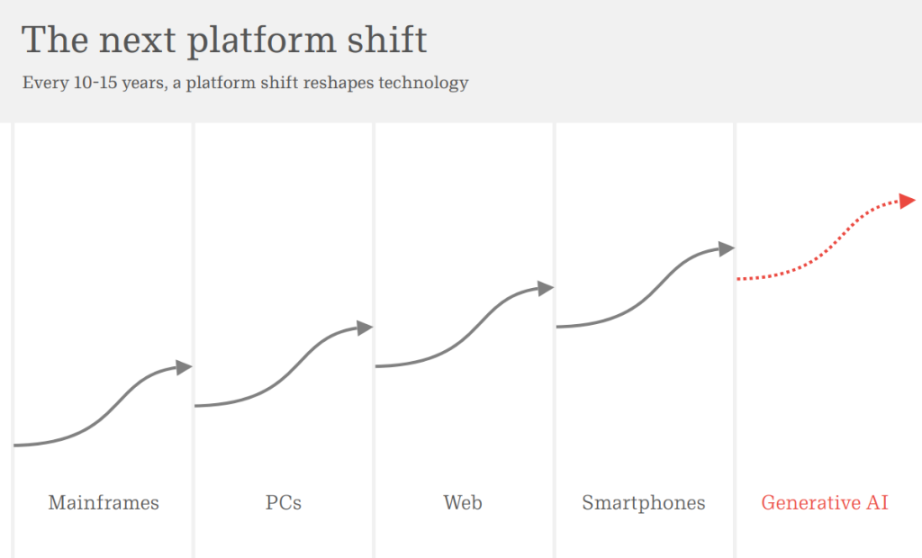
Evans points out that the tech industry's foundation has been completely rewritten every decade or so, from mainframes to PCs, from the internet to smartphones. The emergence of ChatGPT in 2022 may very well mark the beginning of the next "fifteen-year change."
Global tech giants are pouring into an unprecedented investment race. The capital expenditure of Microsoft, Amazon AWS, Google, and Meta is expected to reach $400 billion by 2025—this figure exceeds the annual investment scale of the global telecommunications industry, which is about $300 billion.
"The risk of underestimating AI is far greater than the risk of over-investment," said Microsoft CEO Sundar Pichai, quoted in the report, capturing the essence of industry anxiety.
The report also references the 1956 U.S. Congressional Automation Report and the case of elevator operators disappearing to remind us: when technology truly lands, it quietly becomes infrastructure and is no longer referred to as "AI."
Another fifteen-year change: the historical law of platform transfer
Evans notes in the report that the tech industry experiences a platform shift approximately every ten to fifteen years, from mainframes to personal computers, from the World Wide Web to smartphones, with each shift reshaping the entire industry landscape. Microsoft's case exemplifies the brutality of this shift: the company once held nearly 100% of the operating system market share during the PC era, but became almost irrelevant when the focus shifted to smartphones.
Data shows that Microsoft's operating system market share in global computer sales sharply declined from its peak around 2010, dropping to less than 20% by 2025. Similarly, Apple, which dominated the early personal computer market, was also marginalized by IBM-compatible machines. Evans emphasizes that early leaders often disappear, which seems to be an iron law of platform transfer.

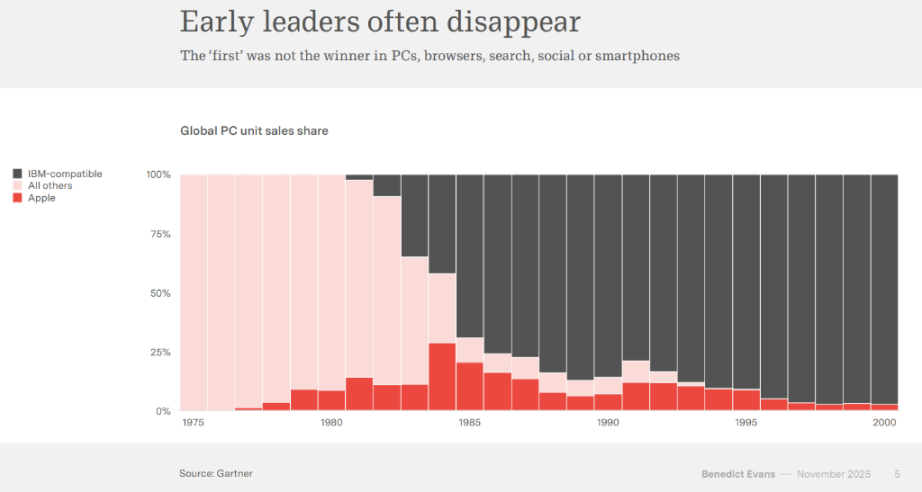
However, three years later, little is still known about the form of this transfer. Evans cites failed ideas from the early internet and mobile internet, such as AOL, Yahoo portals, and Flash plugins. Now it's generative AI's turn, and the possibilities are equally dazzling: browser forms, agent forms, voice interaction, or some entirely new user interface paradigm—no one truly knows the answer.
An unprecedented investment frenzy: a $400 billion gamble
Tech giants are investing in AI infrastructure on an unprecedented scale. By 2025, capital expenditures from Microsoft, AWS, Google, and Meta are expected to reach $400 billion, compared to the global telecommunications industry's annual investment of about $300 billion.

Notably, this growth plan for 2025 has nearly doubled within the year.
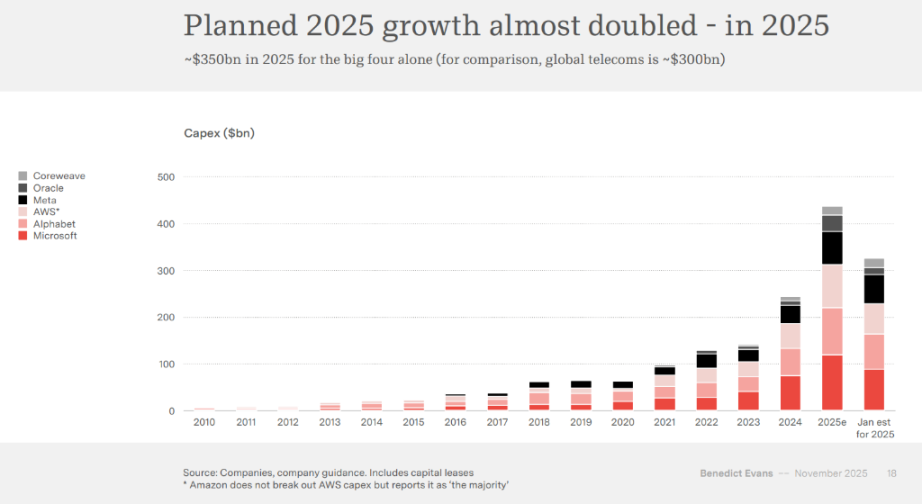
The construction of data centers in the U.S. is surpassing that of office buildings, becoming a new driver of the investment cycle. Nvidia is facing supply bottlenecks due to its inability to keep up with demand, with its quarterly revenue surpassing Intel's accumulated revenue over many years. TSMC is also unable or unwilling to expand capacity quickly enough to meet Nvidia's order demands.
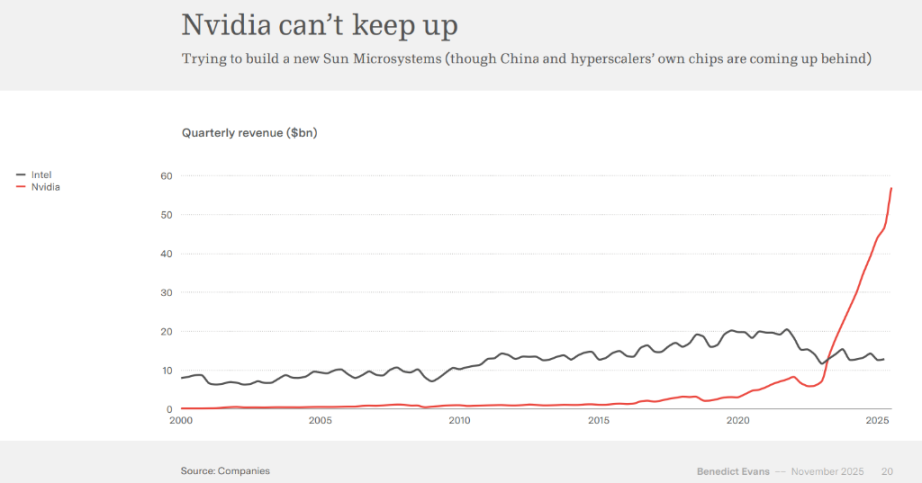
According to an industry survey by Schneider Electric, the main limiting factors for data center construction in the U.S. are public power supply, followed by chip acquisition and fiber access. U.S. electricity demand is growing at about 2%, while AI may add an additional 1% demand, which is not a problem in China but is difficult to build quickly in the U.S.
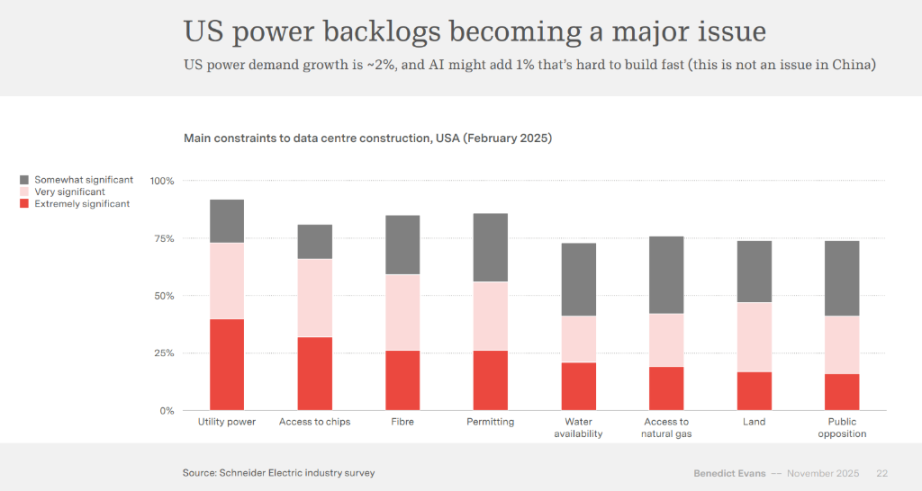
Model convergence: the disappearance of moats, AI may be "commoditized"
Despite the massive investments, the gap in benchmark testing among top large language models is narrowing to single-digit percentages. Evans warns:
If model performance converges highly, it means that large models may be turning into "commodities," and value capture will be reshuffled.
In the most general benchmark tests, the gap between leaders is already very close, and the leadership of models is changing weekly. This indicates that models may be becoming commodities, especially for general purposes.
Evans points out that after three years of development, there has been more progress in science and engineering, but there is still a lack of clear understanding of market forms. While models are still improving, with more models, participation from Chinese manufacturers, open-source projects, and new technology acronyms, the moat is not obvious.
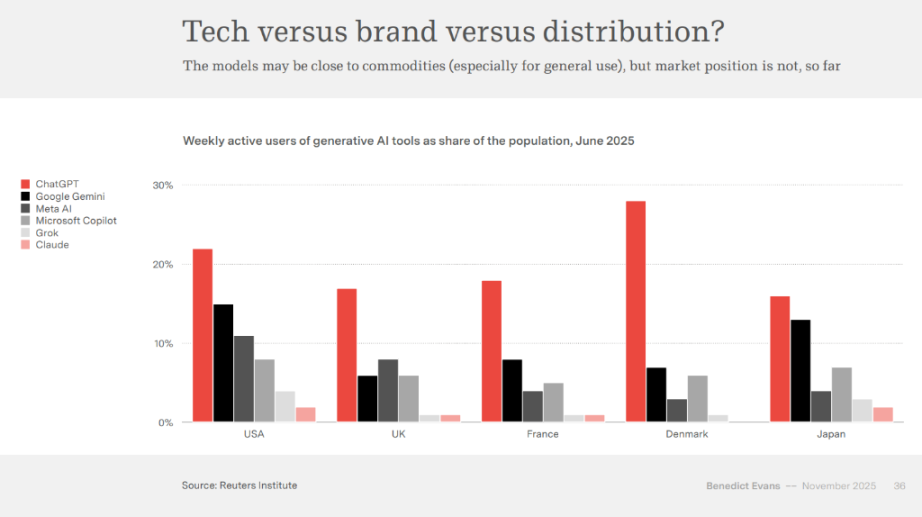
In his view, AI companies must seek new moats in terms of computing power scale, vertical data, product experience, or distribution channels.
The user engagement dilemma: ChatGPT's 800 million weekly active users cannot mask the real lack of stickiness
Although ChatGPT claims to have 800 million weekly active users, user engagement data paints a different picture. Multiple surveys show that only about 10% of U.S. users use AI chatbots daily, with most still in the occasional trial phase.
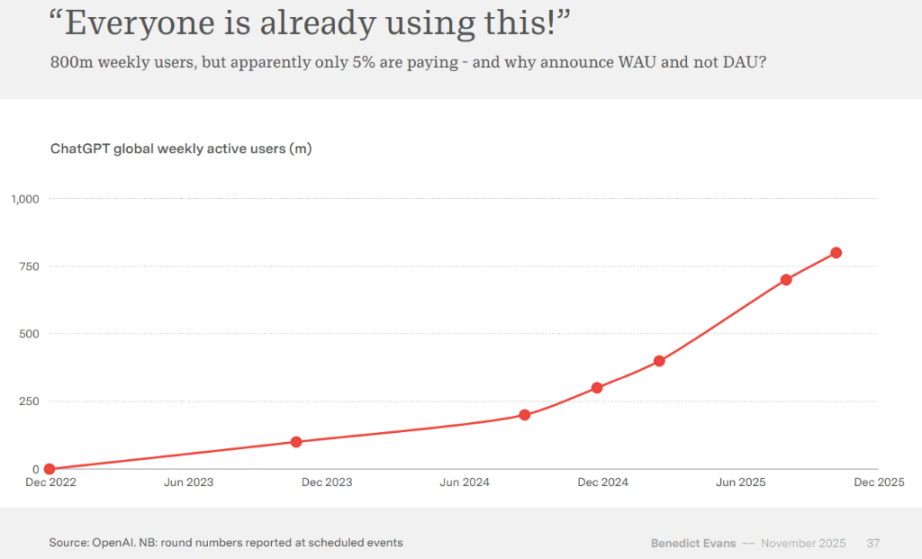
Deloitte's survey data indicates that the number of people who use AI chatbots occasionally is far greater than those who use them daily.

Evans refers to this as a typical "engagement illusion": AI is penetrating rapidly, but it has not yet become a daily tool for everyone.
He analyzes the reasons for this engagement dilemma: how many use cases are obviously simple adaptations? Who has a flexible work environment and consciously seeks optimization? For others, is there a need to package AI into tools and products? This reflects a significant gap between technological capability and practical application.
Enterprise deployment is also slow. The report cites surveys from several consulting firms showing that although enterprises are enthusiastic about AI, there are still few projects that have truly entered production environments.
Deployed: 25%
Planning to deploy in the second half of 2025: about 30%
Not deploying until at least 2026: about 40%
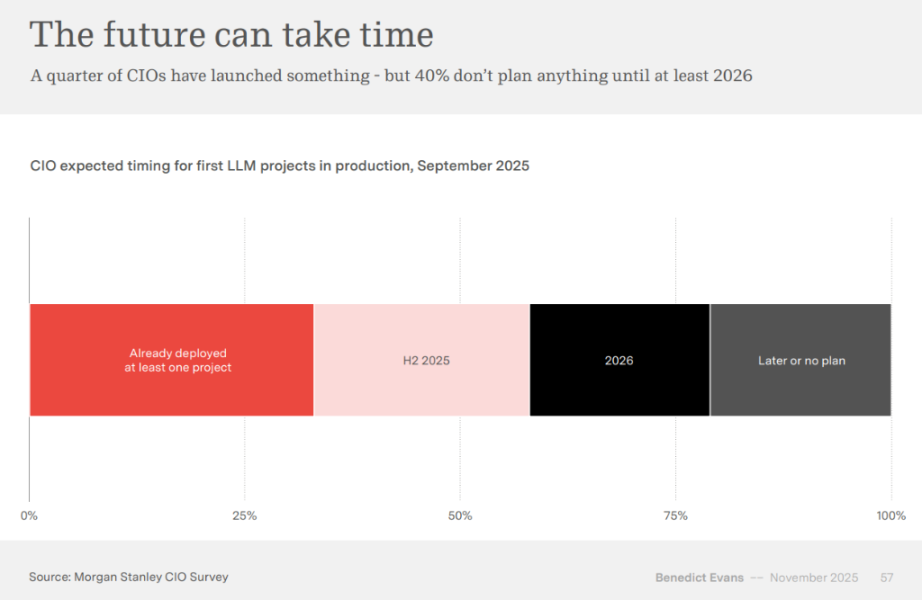
Currently, successful cases are still concentrated in programming assistance, marketing optimization, customer support automation, and other "absorption stages," and there is still a distance from true business reconstruction.
Advertising and recommendation systems face disruptive rewriting
Evans believes that the area where AI will undergo significant changes the fastest is in advertising and recommendation systems.
Traditional recommendations rely on "relevance," while AI has the ability to understand "user intent" itself. This means:
The underlying mechanisms of the trillion-dollar advertising market may be rewritten.
Google and Meta have already disclosed early data: AI-driven advertising can lead to a 3% to 14% increase in conversion rates. The cost of creating advertising creatives may also be further reshaped by automated generation technology from an annual total of $100 billion.

Historical lessons: When automation succeeds, it is no longer referred to as "AI"
Evans brings the perspective back to the 1956 U.S. Congressional Automation Report, pointing out that every wave of automation has sparked significant social discussion, but ultimately it quietly integrates into infrastructure.
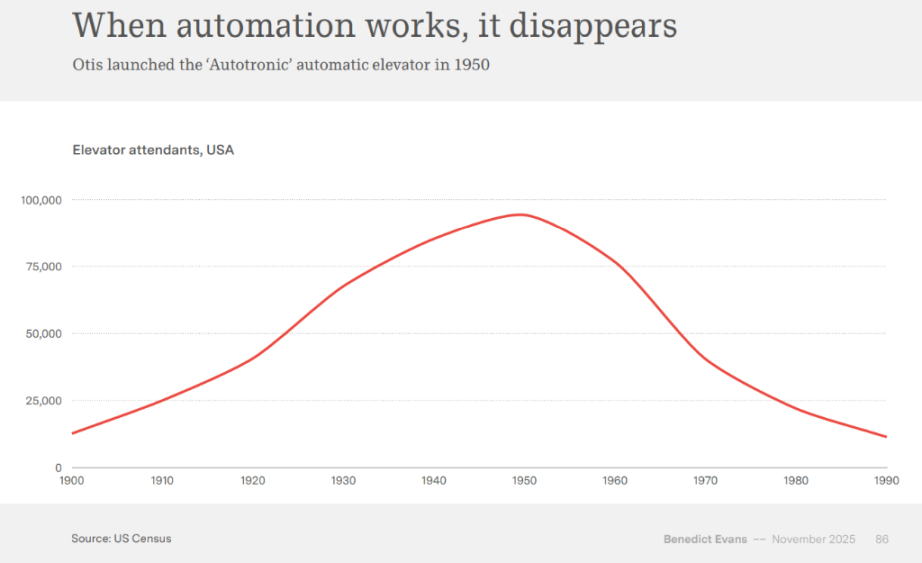
The disappearance of elevator operators, the inventory revolution brought by barcodes, and the internet transitioning from a "novelty" to infrastructure all prove:
When technology truly lands and becomes universal, people will no longer refer to it as "AI."
Evans emphasizes that the future of AI is both clear and murky: we know it will reshape industries, but we do not know the final product forms; we know it will be ubiquitous in enterprises, but we do not know who the dominant players in the value chain will be; we know it requires massive computing power, but we do not know where the growth will stop.
In other words, AI is becoming the protagonist of a new fifteen-year cycle, but the direction of the entire play is still unwritten.
We may be standing on the fault line of the next technological earthquake.
The future of value capture: from network effects to capital competition
For research-intensive, capital-intensive commoditized products, value capture becomes a key issue. If models become commodities and lack network effects, how will model labs compete?
Evans proposes three possible paths: expanding downstream to win by scale, expanding upstream to win through network effects and products, or seeking new dimensions of competition.
Microsoft's case illustrates the shift from competition based on network effects to competition based on capital acquisition capabilities. The company's capital expenditure as a percentage of sales revenue has significantly increased from historical lows, reflecting a fundamental change in competitive patterns.
OpenAI has adopted a "say yes to everything" strategy, including infrastructure deals with Oracle, Nvidia, Intel, Broadcom, AMD, e-commerce integration, advertising, vertical datasets, as well as diversified layouts in application platforms, social video, and web browsers.
免责声明:本文章仅代表作者个人观点,不代表本平台的立场和观点。本文章仅供信息分享,不构成对任何人的任何投资建议。用户与作者之间的任何争议,与本平台无关。如网页中刊载的文章或图片涉及侵权,请提供相关的权利证明和身份证明发送邮件到support@aicoin.com,本平台相关工作人员将会进行核查。




